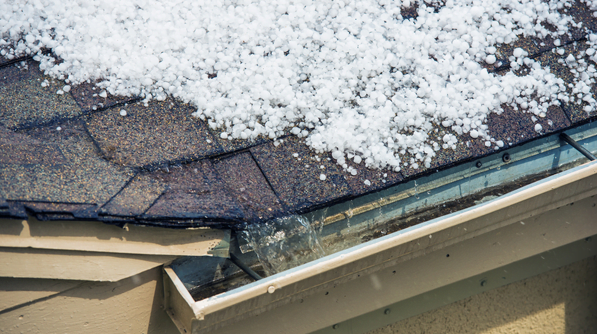The sound of a hailstorm can be one of the most nerve-wracking experiences, especially when you’re worried about your roof. Hailstorms are known for causing high winds and serious damage to roofs – from asphalt shingles being peeled off to punctured, dented, and cracked tiles. Despite the potential destruction hail can bring, with quality roofing work here, you can ensure that your roof will remain strong in the wake of any weather conditions it will face. To give you an idea of the destruction hail can cause, here are 10 of the most severely damaged roofs from hail.

Fractured Fiberglass Cut
Fiberglass roofing materials tend to fragment when hit with large pieces of hail, leaving damaged spatters throughout the roof. These fractured cuts leave behind jagged edges and diffuse layers, which can potentially worsen the damage caused by each successive hailstone. This type of impact on the roof can weaken its structure and lead to heat loss, water leaks, air drafts, and other long-term concerns if left unaddressed.
Loose Shingles
A key indicator of severe harm is lots of loose shingles. Hail’s impact is strong enough that it can partially dislodge them from their place, resulting in them being easy to pull off and even flapping in the wind like a flag. If you take close notice, such signs indicate some major destruction inflicted by those ice balls. It’s important to stay vigilant so the roof can be completely repaired and firmly fixed before further problems occur.
Bruised Shingles
Bruised shingles will have a softer spot when firmly pressed down; it is an indicator that the integrity of the material has been compromised and the roof needs repair work. It’s also a sign that your roof won’t fare well in another hail storm if it hasn’t already been taken care of beforehand. Early detection of damaged shingles could save thousands of dollars and repairs later.
Damaged Gutters, Sidings and Air Conditioners
Gutters and downspouts with dents and marks on windowsills and siding can be telltale signs of roof damage. Of course, outdoor areas with visible hail damage should also throw a red flag; air conditioning units or other exterior appliances are prone to hail damage, thus indicating something bigger must have occurred to the roof above. Those most severely damaged roofs from hail can often take time to repair, so it is important for homeowners to know when to act fast and contact a professional for an inspection.
Weakened Self-Seal Strip
Without a strong strip in place, shingles can remain intact but be significantly weakened. This increased vulnerability leaves your roof exposed to even greater damage and increases the chances of tearing or being blown away when faced with harsh winds. To keep your home safe this hail season, it’s important to contact a roofing professional to assess any damage that could be lurking beneath the surface.
Loose Granules
Loose granules can be an indicator that the shingle quality has been compromised and that small impacts can create leaks. Taking pictures of these details is essential when filing insurance claims and getting contractors to quote repair costs – safety first. However, if looked at differently, it’s almost an opportunity to start fresh and give a home or building the exterior facelift it had been craving.
Black Colored Dots
Although hail can cause a lot of damage, the most severe is usually seen on roofs. It manifests in black colored dots or indentations, which are caused when the hail hits with force and leaves an impression. If left unchecked, these dents can lead to water pooling on the roof and prolonged exposure to moisture leading to major structural problems. They must therefore be identified and replaced before they can cause any further damage.
Split Shingles
Split, cracked, or raised shingles struck by hail not only impair the aesthetic value of a house but can result in extensive and crippling water damage if left unchecked. The perfect combination of velocity and hard texture quickly shreds shingles and leaves seams wide open for the rain to gain entry to what should be an impenetrable defense against the elements.
Impact Dents
Impact dents are often associated with hail damage and appear as random indentations or pockmarks spread along your roof. These dents can vary in size and intensity, making it nearly impossible to tell simply by looking at them if your home was impacted by hail. But if you take notice of dents during the summer months, chances are you’ve incurred some form of hail damage that’ll need to be addressed by a professional.
Cracked Shingles
Cracked shingles look unsightly and leave your roof with bare spots that are no match for inclement weather, exposing your home to all elements. Pay extra attention to cracks in the shingle layers after a hateful hailstorm – ensuring any damages don’t put you in a less-than-ideal situation when Mother Nature rears her head again.
Hail can wreak havoc on your roof, but that doesn’t mean you have to live with the damage. By being aware of the signs of hail damage and taking action accordingly, you can keep your roof safe and secure while avoiding the more costly repairs that come with prolonged exposure to moisture. Learn more about the Composition of Demolition Waste.



